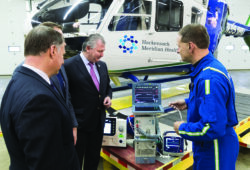Next-generation personalized healthcare devices hold promise of drastically improving patient adherence to self-management regimens and streamlining clinical workflow
Advancements in nanotechnology, computing and wireless connectivity, as well as discoveries in molecular and genetic medicine, are enabling the development of next-generation biosensor tools. These tools, some on the cusp of commercialization, aim to radically improve patient outcomes, streamline clinical workflows and change the way healthcare is delivered.
A biosensor is any device that detects, records and transmits information about a physiological change or process. Applications can vary, but all biosensors require data or a sample, such as blood; a transducer, which converts that sample into an electrical signal; and an electronic system to amplify, process and finally display the signal. Biosensors can be contact-based, implanted, ingested, injected, wearable or require no contact at all.
One of the most ubiquitous examples of a biosensor—the blood glucose meter—was invented more than 40 years ago and required a blood sample. Today, a bevy of non-invasive glucose meters are under development that take different approaches to measuring blood glucose levels. A wearable device developed at the Rochester Institute of Technology uses microwave biotelemetry to detect glucose levels. A subcutaneously implanted device, also developed at the Rochester Institute of Technology, uses nanospheres reacting with glucose in the bloodstream to create a fluorescent signal. Finally, light-based technology developed by Grove Instruments employs laser diodes to measure glucose when held up to one’s fingertip or earlobe.
All of these glucose meters are considered scientific-oriented projects and not yet commercially available, but they have shown tremendous promise, according to Albert Di Rienzo, an industry veteran and president of El Paso, Texas-based RedSky, a company that provides funding and other support to healthcare inventors. “As a result, over time, they will likely be released to the market.”
These next-generation glucose meters, while taking different measurement approaches, all aim to improve patient adherence and outcomes by removing the barriers posed by traditional blood glucose testing.
“For patients with diabetes, the inconvenience, discomfort and expense of regular glucose testing compromises compliance with recommended testing schedules and reduces their ability to manage the condition,” Di Rienzo says. “These non-invasive methods can help improve disease management strategies.”
For congenital heart disease and other cardiac conditions, the CoraLume from Physiowave addresses the problem associated with infrequent critical cardiac monitoring. Since certain cardiac output measurements can only be taken at a medical facility, they’re often not done frequently enough to allow for the accurate identification of trends. CoraLume will allow those measurements to be taken in a patient’s home with a modified bathroom scale that can collect and analyze cardiac output and other vital cardiac measures and transmit that information to the healthcare provider.
For patients taking anticoagulants, a device developed by Abram Scientific aims to simplify the process of getting routine bloodwork. The company has developed a device similar to the blood glucose meter that can quickly measure multiple blood health parameters in real time with a single drop of blood, resulting in better patient adherence to the blood testing schedule, more accurate drug dosing and improved clinical outcomes.
Driving Efficiencies
Other biosensor devices endeavor to solve problems related to clinical workflow. Take the smartphone-based ultrasound imaging system from Mobisante, which is commercially available now. The handheld device provides real-time imaging up to 480 x 800 resolution. Supported transducers include 3.5 and 5.0 MHz for abdominal, OB-GYN and guidance procedures, and 7.5 and 12 MHz for vascular, guidance procedures and small organs.
Di Rienzo notes that clinicians who use the product are getting real-time anatomical and functional information that they could only have gotten before by ordering an ultrasound.
Although it’s not yet on the market, another trend in biosensor development is non-contact-based vital sign monitoring during surgery. This has the dual benefit of being less invasive for the patient, who would no longer require the placement of an arterial line, and offering a more streamlined process for the OR staff.
“That same vital sign information could be captured unobtrusively, simplifying the operating room and making it much cleaner, from an apparatus perspective, and much smarter, with more intelligent, actionable information available to the clinical team,” Di Rienzo says.
Still another trend is mobile health, or mHealth, and there’s a range of biosensors in the works to push boundaries in this area. The Vitaliti by Cloud DX is a wearable device that can measure and record both lifestyle and medical readings, such as heart rate variability, respiration rate, core body temperature, calories burned, blood oxygen saturation and blood pressure. An attachable wand can scan for skin lesions and act as an otoscope or spirometer. The device is currently in prototype as a finalist in the Qualcomm Tricorder XPRIZE competition, which is an ongoing global competition that aims to stimulate innovation in consumer-oriented handheld diagnostics.
“This goes to show how different medicine will be practiced in the future—much less in the acute-care setting, and it will be more personalized.”
Regulatory Hurdles
For now, the smarter OR, all-in-one vital signs wearables and other biosensor capabilities can still be considered science fiction. But they’re marching closer to reality thanks to a slow but steady rate of approvals by the FDA, which considers most of these biosensors as Class II medical devices.
“There’s a fairly substantial bottleneck,” Di Rienzo says. “More and more biosensors are being approved, but not at the rate we would like.”
Sensors with an mHealth component are facing even more regulatory challenges, as developers grapple with which components are subject to regulation by the FDA and states in which they’ll be used.
Share Email





